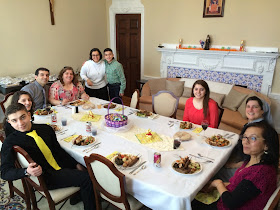The Church
today celebrates the great and wondrous mystery of Christ’s death upon the
cross. Jesus Christ is our new passover who gives us his body and blood as our
spiritual food and drink. He replaces the bread and wine of the paschal meal
with his very body and blood.
The paschal
lamb of the old covenant he abolishes, and in its place he offers himself as
both priest and victim and thus inaugurates the new covenant in his own blood.
As John the
Baptist proclaims, he is truly “the Lamb of God who takes away the sins of the
world.” And as St. Paul says, “Christ our passover has been sacrificed for us;
therefore let us keep the feast.”
The Divine
Mysteries are not celebrated today, instead the pre-sanctified liturgy of the
Anaphora of the Signing of the Chalice is used. The prayers of this anaphora
are among the most ancient of the Syriac Church. Holy Communion is distributed
during the pre-sanctified liturgy from the Mysteries consecrated yesterday.
In addition
to the celebration of the pre-sanctified liturgy the Church also recalls the
mystery of the cross by the rite of adoration of the cross and the burial of
the Lord.
The cross is
the sign of the Lord’s sacrifice and death, and yet it is also the beacon of
light and symbol of hope and victory.
The whole
earth has been enlightened by the light of the cross, and the darkness of
ignorance has been turned back.
As we adore
the cross and recall the burial of the Lord we call out: O Lord, we worship
your cross, for it is our resurrection and renewal.
O Christ
crucified for us, have mercy on us.
HYMN
For us the
Son of Man suffered and died hanging on a cross.
He sent his
spirit to God, the Master of the universe.
The rocks
split and the tombs opened;
the entire
world was afflicted.
The heart
poured water and blood for the life of mankind.
Cross of the
Savior,
teach me of
your power.
Help me to
understand why everyone prostrates
before your
majesty.
I became the
altar at the summit of Golgotha.
On me the
Son of almighty God was crucified.
From him
flowed water and blood for the forgiveness of mankind.
The Church
sings the glory of the cross for ever.
Taken from the Maronite Divine Office (Ramsho) for
Great Friday of the Crucifixion
Maronite Icon: The Crucifixion
The Lord on the cross is dressed with the royal tunic, raising his head like a cub who sleeps with open eyes. His cross is erected on Adam's skull. His Mother looks at him and the Beloved One bows his head. The eclipsed sun and moon symbolize the cosmic presence in this parousia scene. This iconographical type was dominant to the ninth century.








